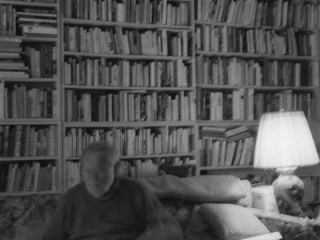Date: 2 November 2003 | Season: London Film Festival 2003 | Tags: London Film Festival
FILM AS A SUBVERSIVE ART
Sunday 2 November 2003, at 7pm
London National Film Theatre NFT3
Paul Cronin, Film as a Subversive Art: Amos Vogel and Cinema 16, UK, 2003, 56 min
Speaking recently about the myriad dangers facing humanity, director-provocateur Werner Herzog cited ‘the lack of adequate imagery’ as one of the most troubling. It’s a view Amos Vogel would surely endorse. As one of America’s most important curators, historians and festival directors, his influence on artists, experimental and underground film cannot be overstated. Born in Austria in 1922 but resident in New York since 1938, Vogel created the path-breaking film society Cinema 16 in 1947, introducing a continent to previously unseen worlds of experience. 20 years on, he established the New York Film Festival and with his eye-changing book ‘Film as a Subversive Art’, penned a revolutionary analysis of the moving image. Now, in Cronin’s valuable tribute to an extraordinary man and his times, Vogel delivers a series of compelling and entertaining reflections on a life lived in the passionate belief that film has a fundamental, radical and ethical role to play in society. Required viewing for anyone who believes cinema matters. Really matters. (Gareth Evans)
followed by
Exhibitionism: Subversive Cinema and Social Change
Following the screening of Film As A Subversive Art: Amos Vogel and Cinema 16 we will be staging a panel discussion focusing on some of the key issues raised in the film.
PROGRAMME NOTES
FILM AS A SUBVERSIVE ART
Sunday 2 November 2003, at 7pm
London National Film Theatre NFT3
FILM AS A SUBVERSIVE ART: AMOS VOGEL AND CINEMA 16
Paul Cronin, UK, 2003, video, colour, sound, 56m
An hour-long profile of Amos Vogel, 82-year old New York resident and Austrian emigré, founder of the New York Film Festival and the Cinema 16 film society.
In 1947, Amos Vogel established a film club in New York called Cinema 16, the most important and influential film society in American history. At its height it boasted thousands of members, inspired a nationwide network of smaller film societies, and gave birth to the very rich tradition of post-war film culture that still exists in the United States. More than a decade before the father of modern ‘independent’ cinema – John Cassavetes – even picked up a camera, Vogel was bringing to a mass audience new ways of looking at world cinema.
The audiences of Cinema 16 were presented with a wide range of film forms, often programmed so as to confront – and sometimes to shock – conventional expectations, including works of the avant-garde, documentaries of all kinds, experimental animation, and foreign or independent features and shorts not in distribution in the United States. From the very beginning Vogel was determined to demonstrate that there was an alternative to industry-made cinema. Initially concentrating on non-fiction, he became the first programmer to show the works of Polanski, Cassavetes, De Palma, Kluge, Oshima, Ozu, Polanski, Rivette and Resnais (among many others) to American audiences. Vogel saw himself as a special breed of educator, using an exploration of cinema history and current practice not only to develop a more complete sense of the myriad experiences film culture had to offer, but also to invigorate the potential of citizenship in a democracy, and cultivate a sense of global responsibility.
Film as a Subversive Art: Amos Vogel and Cinema 16 tells the story of Cinema 16 through a vivid compilation of images and sounds, including a selection of newly filmed interviews with Amos Vogel (erudite and charismatic on-camera) and historian Scott MacDonald, author of a recent book about Vogel and Cinema 16. Vogel is filmed in various New York locations that are pertinent to the history of Cinema 16 and to New York film culture in general. There are rostrum shots of some of the photographs and beautifully designed catalogues and leaflets from Vogel’s extensive Cinema 16 archive. The film also contains excerpts from a selection of films screened at Cinema 16 between 1947 and 1963, including Roman Polanski’s Two Men and a Wardrobe, the infamous Nazi propaganda film The Eternal Jew, and the only film made by legendary New York press photographer Weegee. —Paul Cronin
Back to top
